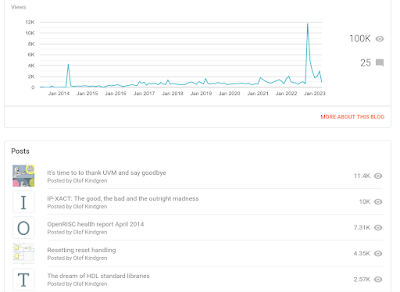Sure, it's not a million, but then again I'm not Arianna Huffington. Given how extremely niche these topics are and that blogging has been declared dead for about a decade now (about as long as I have been blogging, come to think of it), I think that a hundred thousand visitors is actually really really good. It's sure is a lot more than I would ever had imagined when I started doing this ten years ago.
 |
| The proof! Also notice the massive amount of followers this blog has gathered over the years |
I don't remember anymore why I started blogging but I guess I felt that the world deserved to hear my opinions on random things. Also, there wasn't really anyone else writing about the things we were doing with OpenRISC and open source silicon in general at that time. Nowadays, any industry conference and news outlet worth mentioning will have FOSSi content but back then, most people in the industry just didn't get it. (To be fair, most industry people still don't get it given the number of "open source" panels I have seen at conferences consisting of people with zero insights who just sit there making up stuff because their companies have paid to have them there. Thank god for events like ORConf and Latch-Up!).
Enough about why. I thought it could be fun to look at how instead. There are a number of events that have lead to the magic six figure number. So, let's go back to the beginning. What was supposed to be the first article actually became the second article because when I wrote it I went off on a tangent and ended up with a whole article on scope creep instead. And I think that pretty much sums up my writing and how I (fail to) get things done in general by starting something and then ending up getting stuck in some detail and end up doing something completely different instead. Not that it really mattered though. The readership consisted mostly of friends who I forced to read the blog and questioned them afterwards to make sure they had read the whole thing. But I kept writing every now and then about different things around the OpenRISC archicecture. And then one day the people in my regular IRC chat channel notified me that my latest blog post was on the frontpage of Slashdot! For all you youngsters out there, Slashdot used to be the place where all nerds got their news and if you were featured on the Slashdot frontpage during its heydays you'd better have a server that could handle a massive influx of traffic. There were stories about servers burning up after being "slashdotted" because they were humble machines that never thought they would see so many visitors in their life. Luckily, 2014 was a bit after the heydays of Slashdot and Google hosted the blog so I don't think anyone got particularly worried about overloaded servers. But it did make some difference in numbers for the statistics for this humble blog.
 |
| The Slashdot effect in action |
A couple of hours later, the Slashdot crowd moved their attention elsewhere and never came back, as is painfully clear from the statistics. I kept writing now and then however, mostly about FuseSoC, FuseSoC and FuseSoC which apparently didn't lead to any new front page news. A couple of years later though, I wrote about my complicated love-hate relationship with IP-XACT and that seemed to have struck a chord with some people. This one was more of a sleeper hit that didn't cause any immediate sensations but eventually became my most read, and definitely most cited, article I had written.
 |
| IP-Xact - an evergreen of confusing and questionable EDA standards |
Getting noticed in premier geek media and cited in academic circles have both been happy surprises. There's no getting around that does feel a little more fun writing when you get these kind of validations. So I kept writing to a tiny uptick in readership after the IP-XACT article, again mostly about FuseSoC, FuseSoC and FuseSoC, but after starting way too many FOSSi projects over the years, like SERV, SweRVolf and Edalize, I also started doing yearly round-ups partly to remind myself what I did over the past year. And then one evening, after spending a day in a workshop with a clueless EDA vendor trying to shove their awful tooling down our throats, I wrote about one of the FOSSi projects that I believe will have a large impact the coming years, namely cocotb and how it will save us from SystemVerilog for verification. And that, my friends, turned out to be of more interest than anything I had previously written about.
 |
| Cocotb and Python coming to steal the show, as always |
Suddenly, the hordes of geeks coming via Slashdot was just a blip on the radar compared to the angry, happy, confused and relieved verification engineers who showed up en masse to state their opinions, tell their stories, show their support or ask what this was all about.
Not everyone agreed, but it was clear that it was a hot topic. And that's the third thing I'm really happy about, to have ignited discussions around the status quo of chip design and get people to bring their ideas and opinions to the table.
I really hope to continue writing about stuff when I'm in the mood and can find the time. And hopefully some people find it interesting, at least occasionally. Given the sporadic output of the past, we will never know the next time that happens, so I'll just say until then!
No comments:
Post a Comment